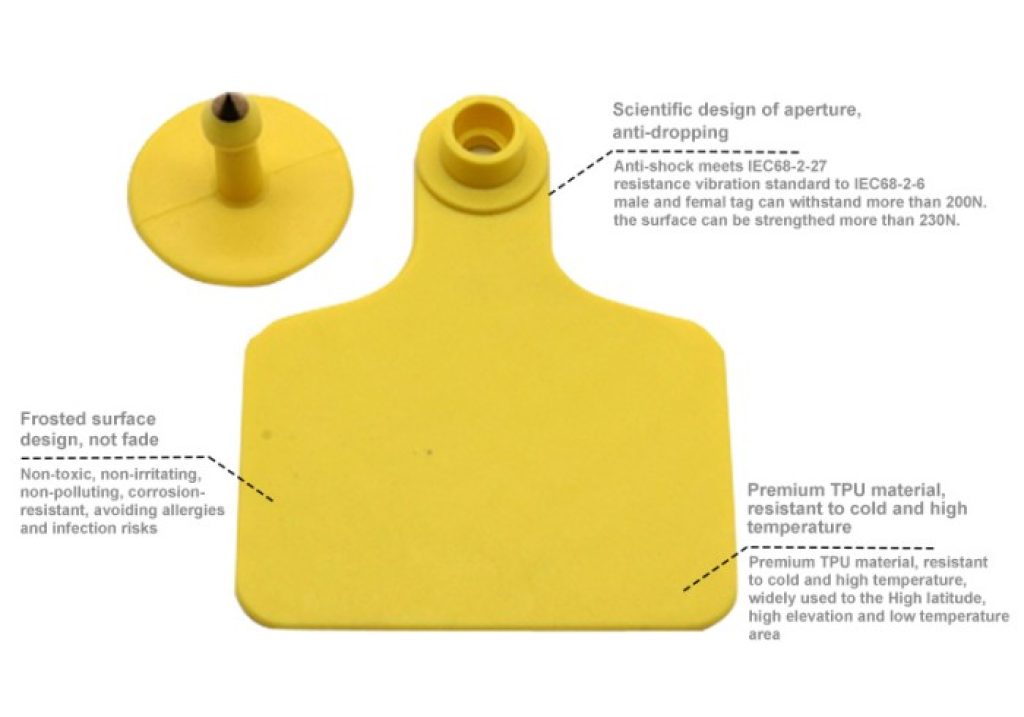Introduction
In a world where technology continues to reshape our lives, it’s no surprise that even our furry, feathered, and hoofed companions are becoming part of the digital age. RFID (Radio-Frequency Identification) technology has quietly revolutionized the way we track, manage, and care for animals. In this article, we’ll take a closer look at the fascinating world of RFID animal tags, exploring their significance, applications, benefits, and the future of animal tracking.
What Are RFID Animal Tags?
If you’re not already familiar with RFID animal tags, you’re in for a treat. These small electronic devices use radio-frequency signals to identify and track animals. Each tag carries a unique code that allows for individual recognition, making it a game-changer for various industries.

The Significance of RFID in Animal Tagging
RFID technology has significantly improved the way we manage animals in diverse environments. Whether it’s livestock on a farm, wildlife in a conservation area, or even beloved pets in our homes, RFID Animal Tags offer precision and efficiency in tracking and monitoring.
Purpose of the Article
This article aims to demystify RFID animal tags, providing a comprehensive understanding of their functionality, benefits, and applications. From discussing the types of RFID Animal Tags to exploring real-life case studies and addressing environmental concerns, we’ve got it all covered. So, let’s dive into the world of RFID animal tags.
Understanding RFID Technology
The Basics of RFID
Before we venture further, let’s establish a solid foundation. We’ll start with the basics of RFID technology, including how these tags work and the fundamental principles behind them.
How RFID Works in Animal Tagging
Understanding the inner workings of RFID technology is crucial. We’ll delve into the process of how these tags identify and communicate with the reader devices.
Types of RFID Tags for Animals
Not all RFID tags are created equal. We’ll explore the different types of tags used for animals, each designed to meet specific needs and challenges.
Benefits of RFID Animal Tags
Enhanced Livestock Management
For farmers and ranchers, RFID animal tags have transformed the way they manage livestock. We’ll discover how these tags streamline tasks, boost efficiency, and lead to healthier herds.
Wildlife Conservation
In the realm of wildlife conservation, RFID tags play a crucial role. Researchers use them to monitor and protect endangered species, learn about migration patterns, and understand animal behavior.
Data Collection and Analysis
The wealth of data generated by RFID tags is a goldmine for animal research. We’ll uncover how this data helps us make informed decisions, whether in a farm or a conservation setting.
Types of Animals Tagged
Livestock Tagging
Let’s start with the animals we see on farms. We’ll explore how RFID tags are applied to livestock and the benefits they bring to this industry.
Wildlife Tracking
In the wild, RFID technology plays a critical role in tracking and preserving wildlife. We’ll look at specific examples of how these tags are used in conservation efforts.
Pet Identification
Even our pets benefit from RFID technology. From lost-and-found services to pet health records, we’ll discuss how these tags ensure the safety of our furry friends.
Choosing the Right RFID Animal Tags
Considerations for Livestock
Selecting the right RFID tag for livestock is a crucial decision for farmers. We’ll delve into the key considerations when choosing tags for different animals.
Wildlife-Specific Tags
In the wild, not all animals are the same. We’ll explore RFID tags designed for wildlife and the unique challenges they address.
Pet-Friendly RFID Animal Tags
Our pets deserve the best. We’ll look at RFID tags suitable for pets, addressing their specific needs and safety concerns.
RFID Tag Application Process
Step-by-Step Guide for Tagging Livestock
Farmers and ranchers need to know how to apply RFID tags correctly. We’ll provide a step-by-step guide for the smooth tagging of livestock.
Wildlife Tagging Procedures
In the world of wildlife conservation, tagging animals is no small task. We’ll uncover the procedures and methods used in tagging wild creatures.
Pet Tagging and Registration
For pet owners, the process is different. We’ll explain how pet tagging and registration work, ensuring your furry friend is safe and secure.
Maintenance and Data Management
Ensuring Tag Functionality
Once the tags are applied, the journey is far from over. We’ll discuss how to ensure these RFID Animal Tags function correctly and offer long-lasting benefits.
Handling and Storing Data
The data generated by RFID tags is invaluable. We’ll explore how to handle and store this data effectively and responsibly.
Privacy and Ethical Considerations
With data comes responsibility. We’ll address privacy concerns and ethical considerations related to RFID animal tagging.
Real-Life Applications of RFID Animal Tags
Case Study 1: RFID in Livestock Farming
To see the impact of RFID in action, we’ll dive into a real-life case study in livestock farming. Discover how it transformed a traditional industry.
Case Study 2: RFID in Wildlife Conservation
Wildlife conservation is crucial in our rapidly changing world. We’ll explore a case study highlighting how RFID tags help protect endangered species.
Case Study 3: Pet Identification Success Stories
For pet owners, RFID Animal Tags offer peace of mind. We’ll share success stories where these tags led to joyful reunions with lost pets.
Environmental Impact
Eco-Friendly Aspects of RFID Animal Tags
RFID tags aren’t just about convenience; they also have eco-friendly attributes. We’ll discuss how RFID contributes to environmental sustainability.
Responsible Disposal and Recycling
What happens when an RFID Animal Tags reaches the end of its life? We’ll address responsible disposal and recycling practices.
Future Trends
Miniaturized RFID Tags
The future of RFID is getting smaller. Miniaturized tags are on the horizon, and we’ll explore what this means for the industry.
Data Analytics and Artificial Intelligence
The power of data is growing. We’ll discuss how RFID technology is evolving to embrace data analytics and artificial intelligence.
Integration with Internet of Things (IoT)
The IoT is changing the way we connect devices. We’ll look at how RFID Animal Tags are integrating with the IoT to create smart and connected ecosystems.
Legislation and Regulations
Current Laws and Regulations
In a world governed by rules, we’ll outline the current laws and regulations surrounding RFID animal tagging.
Compliance in Animal Tagging
Understanding the legal requirements is vital. We’ll delve into what it takes to be compliant with the law when using RFID Animal Tags.
Challenges and Concerns
Health and Safety Concerns
While RFID technology has many benefits, there are concerns to address. We’ll explore the potential health and safety issues associated with these RFID Animal Tags.
Data Security and Privacy
In a digital age, data security is paramount. We’ll discuss how RFID tags handle data and the privacy concerns they raise.
Ethical Considerations
Ethics play a significant role in animal tagging. We’ll dive into the ethical considerations surrounding the use of RFID technology on animals.
RFID Animal Tags in Research
Scientific Studies and Findings
The scientific community has been busy. We’ll examine various studies and findings related to RFID animal tags.
Advancements in Animal Behavior Research
Understanding animal behavior is crucial for conservation and welfare. We’ll look at how RFID tags have advanced the field of animal behavior research.
Global Adoption and Impact
RFID in Agriculture and Farming
In the agricultural world, RFID tags are changing the game. We’ll explore the widespread adoption of this technology and its impact.
Conservation Efforts Worldwide
From tracking sea turtles to protecting rhinos, we’ll take a global tour of how RFID technology is being used in conservation efforts.
Pet Ownership and RFID
Even pet owners are embracing RFID. We’ll discuss how this technology is improving the lives of pets and their owners.
Choosing the Right RFID Animal Tag Manufacturer
Factors to Consider
Selecting a tag manufacturer is a critical choice. We’ll highlight the key factors to consider when choosing the right manufacturer.
Top Manufacturers in the Market
Not all manufacturers are equal. We’ll showcase some of the top RFID tag manufacturers, helping you make an informed decision.
ROI and Cost Analysis
Cost-Benefit Analysis for Farmers
For farmers, the bottom line is essential. We’ll break down the costs and benefits of using RFID tags in agriculture.
Wildlife Conservation ROI
In the conservation world, return on investment comes in different forms. We’ll explore how RFID tags contribute to the ROI of wildlife conservation.
Pet Owners’ Perspective
Pet owners know that every investment matters. We’ll discuss the costs and benefits from a pet owner’s point of view.
Innovation and Technology Evolution
Latest Technological Advancements
RFID technology is evolving rapidly. We’ll look at the latest advancements that are reshaping the industry.
Industry Innovations and Research
Innovation drives progress. We’ll explore how industry leaders are pushing the boundaries of RFID technology.
Security and Data Integrity
Measures to Ensure Data Security
Security is a top concern. We’ll detail the measures in place to ensure the data generated by RFID tags remains secure.
Preventing RFID Tag Tampering
As with any technology, tampering is a potential threat. We’ll discuss measures to prevent tampering with RFID tags.
Integration with Other Technologies
Combining RFID with GPS
In the world of connectivity, RFID and GPS make a powerful pair. We’ll look at how these technologies work together.
RFID and Mobile Apps
Smartphones are ubiquitous, and RFID tags are joining the mobile revolution. We’ll discuss how these tags interact with mobile apps.
RFID in Smart Homes
Smart homes are on the rise. We’ll explore how RFID technology integrates with the concept of a smart home.
Conclusion and Key Takeaways
The Transformative Power of RFID Animal Tags
The journey through the world of RFID animal tags has been enlightening. We’ll summarize the transformative power of these tags in a variety of settings.
Final Thoughts and Insights
In conclusion, we’ll offer our final thoughts and insights, emphasizing the significance of RFID technology in animal tracking.
Encouragement for Adoption and Responsible Usage
We’ll end our journey with a call to action. We encourage the adoption of RFID technology while stressing the importance of responsible and ethical usage.
FAQs (Frequently Asked Questions)
- Can RFID tags harm animals? RFID tags are designed to be safe for animals. They are typically small and lightweight, causing minimal discomfort when properly applied. However, incorrect application or use of excessively large tags can potentially harm animals. It’s essential to follow guidelines and choose appropriate tags for the species.
- Are RFID tags reusable? RFID tags come in both reusable and non-reusable options. Reusable tags are typically more durable and can be attached to multiple animals throughout their lifespan. Non-reusable tags are designed for single-use and are usually more affordable.
- What is the average lifespan of an RFID tag’s battery? The lifespan of an RFID tag’s battery varies depending on the type of tag and its usage. Some tags have batteries that can last for several years, while others may have a shorter lifespan. It’s essential to check the manufacturer’s specifications for battery life.
- Is there a risk of data loss with RFID tags? Data loss with RFID tags is rare, but it can occur if the tag is damaged or if there are interference issues with the reader. To minimize the risk, regular maintenance of tags and readers is recommended.
- Are there privacy concerns with RFID animal tagging? Privacy concerns primarily apply to human-related RFID applications. However, in some cases, privacy concerns may arise if RFID tags are used in ways that impact wildlife behavior or habitat. Ethical usage and data protection measures are essential in addressing these concerns.
- How do I choose the right RFID tag for my pet? When selecting an RFID tag for your pet, consider factors such as the tag’s size, material, and compatibility with the tracking system used by local authorities. It’s also important to ensure that the tag meets any legal requirements for pet identification in your region.
- Can RFID tags be tracked over long distances? The tracking range of RFID tags varies depending on the type of tag and the reader’s capabilities. In general, passive RFID tags have a shorter range (typically a few feet), while active RFID tags can be tracked over longer distances (up to several meters). The range is determined by the tag’s frequency and power source.
- Are there size limitations for RFID tags on different animals? Yes, there are size limitations for RFID tags, and they vary depending on the animal’s size and the application. Smaller animals, such as birds, require smaller tags, while larger animals can accommodate larger tags. It’s important to choose a tag size that suits the animal’s species and size.
- What are the future trends in RFID animal tagging? The future of RFID animal tagging is expected to include advancements in tag miniaturization, improved data analytics, and integration with the Internet of Things (IoT). These trends will enhance tracking capabilities and provide more insights into animal behavior.
- How do RFID tags impact the environment? RFID tags have a positive environmental impact by reducing the need for physical paperwork and minimizing the use of resources. Additionally, eco-friendly RFID tag options and responsible disposal practices help minimize environmental impact.
- What legislation governs RFID animal tagging? Legislation related to RFID animal tagging varies by region and country. It typically addresses issues such as animal welfare, privacy, and data protection. Local and national authorities may have specific regulations governing the use of RFID tags on animals.
- Are there any health concerns with RFID tags? Health concerns related to RFID tags are minimal. The tags are designed to be safe for animals, and adverse health effects are rare. However, it’s essential to monitor tagged animals for any signs of discomfort or irritation and seek veterinary advice if necessary.
- How do I dispose of old or damaged RFID tags responsibly? Responsible disposal of old or damaged RFID tags is essential to protect the environment. Many manufacturers provide guidance on proper disposal methods, including recycling or returning tags to the manufacturer for safe disposal.
- What are the key challenges faced in RFID animal tagging? Challenges in RFID animal tagging include ensuring tag functionality, addressing data security and privacy concerns, and navigating ethical considerations. It’s essential to overcome these challenges for the responsible use of RFID technology on animals.
- How are RFID tags used in scientific research? RFID tags are valuable tools in scientific research, particularly in tracking animal behavior, migration patterns, and population dynamics. Researchers use RFID data to gain insights into wildlife and livestock, contributing to scientific knowledge.
- How has RFID impacted global agriculture and wildlife conservation? RFID technology has transformed global agriculture by improving livestock management and data collection. In wildlife conservation, RFID tags have played a significant role in tracking and protecting endangered species and understanding their behavior.
- What is the future of RFID in the animal tagging industry? The future of RFID in the animal tagging industry is bright. Advancements in miniaturization, data analytics, and integration with IoT will enhance tracking capabilities. RFID will continue to be an invaluable tool in various animal-related fields.
- How do I choose a reliable RFID tag manufacturer? To choose a reliable RFID tag manufacturer, consider factors like product quality, reputation, customer reviews, and compliance with industry standards. It’s crucial to select a manufacturer with a track record of producing high-quality RFID tags.
- What is the typical return on investment for RFID tagging? The return on investment for RFID tagging varies depending on the industry and application. Farmers may see ROI through increased efficiency, while conservation efforts may measure ROI in terms of species preservation and research data.
- How can I ensure the security and integrity of RFID data? To ensure the security and integrity of RFID data, use encryption and access controls. Regularly update security measures and stay informed about potential threats to protect the data generated by RFID tags.


















